The American 5th Infantry Division had returned to the line on the 9th of November 1944 when where they took up defensive positions. The 2nd Infantry Regiment was the most advanced Regiment of the division and took up positions around four village areas. Indications were that to the front was 17th SS Panzer Grenadier Division Götz von Berlichingen.
The American regimental commander deployed 1st Battalion forward holding a town and woods to the regiments front. These troops were well positioned to disrupt any German counter attack. Behind 1st Battalion, 2nd Battalion provided a strong second line while a reinforced company was oriented north to protect the likely direction that a German flank attack would come from. Below, the 1st Battalion sector from the northeast. The 2nd Battalion reinforces the position with supporting dispositions.
The American 3rd Battalion was deployed to the right of 1st Battalion taking advantage of high ground and wooded slopes provided advantageous positions for screening the regiments flank. A platoon sized team secured a small village on the right rear, near which divisional mortars were placed. Each battalion was supported by an understrength company of M-36 Jacksons. Two artillery battalions were on call, as was the usual American aircraft.
Above, the area of operations viewed from the north. American 1st & 2nd Battalions are in the foreground, while the 3rd Battalion is in the top left.
To the east elements of the 17th SS Panzer Grenadier Division under command of SS-Standartenführer Gustav Mertsch was forming for a hasty attack. Mertsch allocated 37th Panzer Grenadier Regiment for the operation and reinforced it with a Kampfgruppe built around surviving elements of the divisional Panzerjäger battalion and reconnaissance battalions. SS-Obersturmbannführer Hans Lingner would command the attack which would be directly supported by two 105mm artillery battalions and a werfer battalion. Finally a 150mm artillery battalion was allocated for counter-battery fire.
Reconnaisance prior to the attack had built up a general picture of the American positions, which comprised three battalions in the sector with greater strength to the American left. However, the exact positions of American forces was unclear. Lingner determined to launch a phased operation, with each attack going in silent. First to move was his 1st Panzer Grenadier Battalion which moved over open ground towards a short wooded ridge behind a village. This was the battalions first objective. To the left a small but steep hill providing excellent visibility was to be secured and was clearly an important objective. With 1st Battalion advancing and approaching the likely enemy positions the 2nd Panzer Grenadier Battalion moved forward to the right of 1st Battalion. 2nd Battalion was tasked with supporting 1st Battalion’s attack, if needed, and securing a village. The battalions were then go into defensive positions. 3rd Panzer Grenadier Battalion was further to the right and held back in reserve to act as a follow-on battalion. As 1st and 2nd Battalions engaged the enemy right the Panzerjäger Kampfgruppe, Kampfgruppe Wahl, was to conduct a swift deep flanking movement against the unprotected in the American right. It was critical this battalion was to advance with speed and break into the rear areas. As this attack developed 1st Panzer Grenadier Battalion would support by moving against the now exposed American right flank.
In this aerial photograph above the 1st and 2nd Battalions of the 37th Panzer Grenadier Regiment are seen to be advancing in the top left.
Above, the 1st Panzer Grenadier Battalion secures a small village while their objectives, a steep hill in the front and enemy positions on the wooded hill to the right are visible. Below, a view from 2nd Panzer Grenadier Battalion as it advances to the right of 1st Battalion. American infantry and tank destroyers have engaged 1st Battalion. In the following turn German Nebelwerfers and 105mm artillery saturate the American position forcing the survivors to retire.
In the following turn German Nebelwerfers and 105mm artillery saturate the American position forcing the survivors to retire. The Panzer Grenadiers of 1st Battalion now advanced seizing the wooded ridge and engaging the retiring American survivors with small arms and in the case of the retiring tank destroyers with Panzerfausts.
American 155mm artillery now joined in firing at the advancing infantry, the resulting suppressions visible above, top left. This was met by counter-battery fires by German 150mm guns firing at extreme range. Despite locating the American artillery quickly the counter-battery fires were frustrating ineffective, continually suppressing rather than destroying the American artillery. Also visible above in the foreground are German trucks towing Pak 40 anti-tank guns. These were allocated to each Panzer Grenadier battalion for possible use against American counter-attacks.
It was at this time that the flanking action by the Kampfgruppe Wahl entered. Divided in to two groups, in an effort to navigate the dense terrain on the American right, the unit moved rapidly forward.
The Kampfgruppe comprised 28 Stugs and was supported by a company of Panzer Grenadiers in 250/1s halftracks, a number of Sdkfz 250/9 reconnaissance halftracks and two sections of quad 20mm flak vehicles. They can be seen above advancing on the right rear of the American position. The village was found to be held by a single American platoon. Beyond the village was an American 106mm mortar battalion which was overrun by the advancing troops.
Above, the view from the American mortar battalion position as Stugs advance. These Stugs are the less effective L/43 version pulled into service by the division from serveral reserve and training formations to supplement the division’s limited armoured units.
Below, the general situation with Panzer Grenadiers attacking the American 3rd Battalion from the front while the Kampfgruppe Wahl advances on the rear.
As the German Kampfgruppe Wahl advanced through the rear areas they came under a series of Jabo attacks. The first, shown below, was ineffective due to well placed 20mm flak. The second however was delivered after the flak had been neutralised and resulted in a number of destroyed Stugs. Below, Jabos deliver an attack run, a Sdkfz 250/9 is visible in the foreground.
Above, Jabos deliver the first attack run, a Sdkfz 250/9 is visible in the foreground. Below, another attack targets on another group of Stugs.
The Kampfgruppe Wahl had now advanced deep behind the American position but had now become dangerously outstretched. Obersturmbannführer Lingner had issued several order changes.
1st Panzer Grenadiers had been issued follow on orders which was to see them push into the second line of the American 3rd Battalion. However a lack of artillery support delayed the attack. Until the attack finally went in the American battalion retained a strong blocking position. Finally, when the American 3rd Battalion broke in route the Panzer Grenadiers were now unable to support the Kampfgruppe Wahl as planned.
Further, the 2nd Panzer Grenadier Battalion was taking heavy casualties from elements of the American 1st Battalion, especially direct support fires by tank destroyers, and finally a platoon counterattack by anti-aircraft half tracks. There position risked being comprised and with German casualties rising quickly Lingner had no choice but to commit his 3rd Panzer Grenadier battalion, visible below in the foreground, in an effort to maintain momentum.
Above, foreground 3rd Panzer Grenadiers advance in support of 2nd Panzer Grenadier. Top left Stugs of Kampfgruppe Wahl are engaged in an exchange with tank destroyers supporting the 2nd American Battalion. Portions of the battalion had relocated east facing positions to face south to slow the German flank attack. American artillery has fired smoke to isolate portions of the Kampfgruppe Wahl so the outnumbered Americans can concentrate their fire. In the centre American M16 halftracks conduct a company sized local counter-attack to apply pressure on the 2nd Panzer Grenadier Battalion, which was near breaking. This couster-attack was driven back by hastily deployed Pak-40 anti-tank guns.
With casualties mounting, fading light and the momentum of the attack clearly lost, Lingner now called his attack off. Casualties on the Kampfgruppe Wahl had been heavy and while the morale was high the commander was unable to advance further. 2nd Panzer Grenadier had suffered heavy casualties and further operations would have been unwise. Three objectives had however been secured and one American battalion shattered. The 37th Panzer Grenadier Regiment had acquitted itself well, though the crushing victory so needed, remained elusive.
The scenario was developed using the Scenario Generation System and involved a hasty attack by the Germans who reinforced their attack with an Option A, the werfer battalion. By the end of the game three objectives had been secured while the Panzerjäger battalion had been forced to check morale. The Americans had also taken an Option A reinforcement, a 155mm artillery battalion. They retained two objectives but had lost one battalion, it had been forced to test morale twice. The result was therefore a winning 7-5 draw to the Germans.

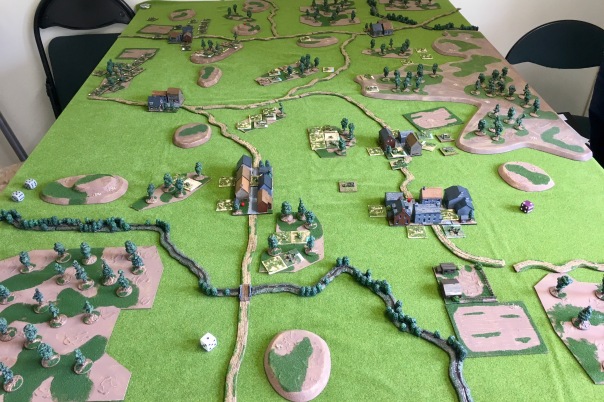

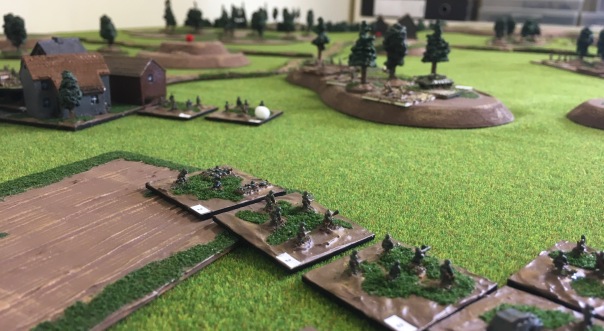

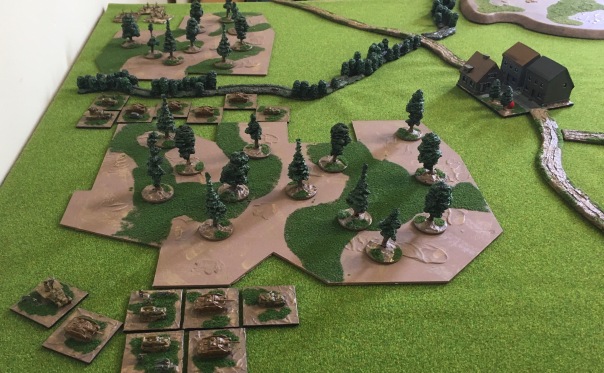

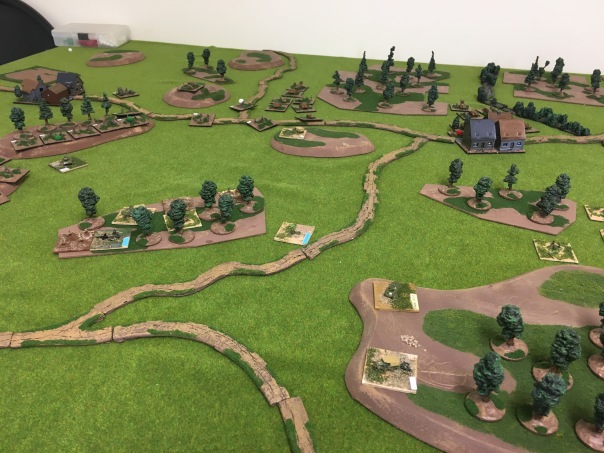
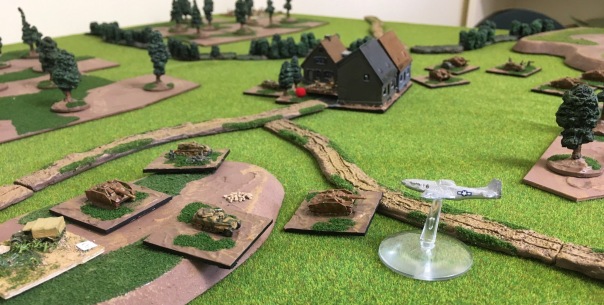


Very nice batrep – it’s good to see SH back in the mix.
Thanks for your comment. I’m pleased you enjoyed the report.
You are correct it has been too long between games. This scenario more than made up for it though, as it was rather balanced as the initial German advantage slowly slipped away and American resolve stiffened. A great game.